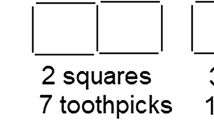Abstract
This issue of ZDM collects research works sharing a common reference to the theoretical framework of Mathematical Working Spaces (MWS), a construction which emerged about one decade ago, and has progressively found its way in the mathematics education community, thanks to the collaborative work of an international group of researchers. In this reaction paper, I approach this new theoretical construction, using the concept of research praxeology which has been introduced to support practices of networking between theoretical approaches. After a short introduction, in the first section of this reaction paper, I introduce this concept and explain how it shapes my reading of the different contributions, before expressing the vision of the MWS framework and of its educational potential it leads to. In the final section, I point out some questions and challenges regarding the MWS theoretical framework emerging from the use of this specific lens.
Similar content being viewed by others
References
Artigue, M., & Bosch, M. (2014). Reflection on networking through the praxeological lens. In A. Bikner-Ahsbahs & S. Prediger (Eds.), Networking of theories as a research practice in mathematics education (pp. 249–266). New York: Springer.
Artigue, M., Bosch, M., & Gascón, J. (2011). Research praxeologies and networking theories. In M. Pytlak, T. Rowland, & E. Swoboda (Eds.), Proceedings of the Seventh Congress of the European Society for Research in Mathematics Education CERME7 (pp. 2381–2390). Rzeszów: University of Rzeszów.
Artigue, M., & Mariotti, M. A. (2014). Networking theoretical frames: The ReMath enterprise. Educational Studies in Mathematics, 85(3), 329–356.
Bikner-Ahsbahs, A., & Prediger, S. (Eds.). (2014). Networking of theories as a research practice in mathematics education. New York: Springer.
Brousseau, G. (1997). Theory of didactical situations in mathematics. New York: Springer.
Chevallard, Y. (1985). La transposition didactique [The didactical transposition]. Grenoble: La Pensée Sauvage.
Chevallard, Y., & Sensevy, G. (2014). Anthropological approaches in mathematics education, french perspectives. In S. Lerman (Ed.), Encyclopedia of mathematics education (pp. 38–43). New York: Springer.
Derouet, C., & Parzysz, B (2016). How can histograms be useful for introducing continuous probability distributions? ZDM Mathematics Education, 48(6) (this issue). doi:10.1007/s11858-016-0769-9.
Duval, R. (1995). Sémiosis et pensée humaine [Semiosis and human thinking]. Bern: Peter Lang.
Gómez-Chacón, I., Romero Albaladejo, I. Ma, & del Mar García López, Ma (2016). Zig-zagging in geometrical reasoning in technological collaborative environments: A Mathematical Working Space-framed study concerning cognition and affect. ZDM Mathematics Education, 48(6) (this issue). doi:10.1007/s11858-016-0755-2.
Hitt, F., Saboya, M., & Cortés Zavala, C. (2016). An arithmetic-algebraic work space for the promotion of arithmetic and algebraic thinking: triangular numbers. ZDM Mathematics Education, 48(6) (this issue). doi:10.1007/s11858-015-0749-5.
Houdement, C., & Kuzniak, A. (2006). Paradigmes géométriques et enseignement de la géométrie. Annales de Didactique et de Sciences Cognitives, 11, 175–193.
Kuzniak, A., Nechache, A. & Drouhard, J.-P. (2016a). Understanding the development of mathematical work in the context of the classroom. ZDM Mathematics Education, 48(6) (this issue). doi:10.1007/s11858-016-0773-0.
Kuzniak, A., Tanguay, D., & Elia, I. (2016b). Mathematical working spaces in schooling: An introduction. ZDM Mathematics Education, 48(6) (this issue).
Minh, T. K. & Lagrange, J.-B. (2016). Connected functional working spaces: a framework for the teaching and learning of functions at upper secondary level. ZDM Mathematics Education, 48(6) (this issue). doi:10.1007/s11858-016-0774-z.
Prediger, S., Bikner-Ahsbahs, A., & Arzarello, F. (2008). Networking strategies and practices for connecting theoretical approaches: first steps towards a conceptual framework. ZDM, 40(2), 165–178.
Richard, P. R., Oller Marcén, A. M., & Meavilla Seguí, V. (2016). The concept of proof in the light of mathematical work. ZDM Mathematics Education, 48(6) (this issue). doi:10.1007/s11858-016-0805-9.
Vergnaud, G. (1991). La théorie des champs conceptuels [The theory of conceptual fields]. Recherches en Didactique des Mathématiques, 10(2–3), 133–170.
Author information
Authors and Affiliations
Corresponding author
Rights and permissions
About this article
Cite this article
Artigue, M. Mathematical working spaces through networking lens. ZDM Mathematics Education 48, 935–939 (2016). https://doi.org/10.1007/s11858-016-0810-z
Accepted:
Published:
Issue Date:
DOI: https://doi.org/10.1007/s11858-016-0810-z




